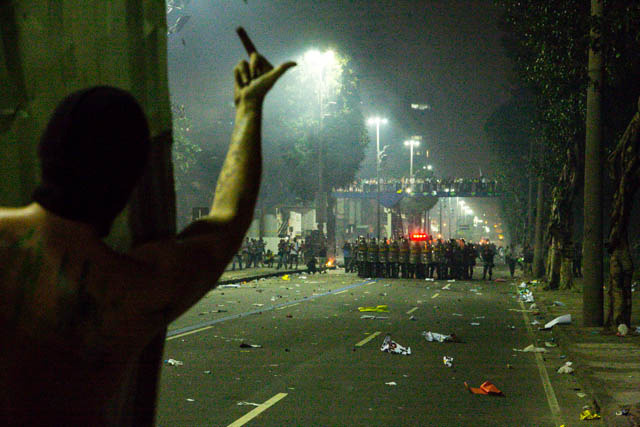On June 20 somewhere between 300,000 and a million people took to the streets of Rio de Janeiro to celebrate the cancellation of the public-transportation fare hikes that had set off nationwide protests in Brazil throughout June. But the jubilation in Rio was short lived as civilians and police engaged in some of the most violent, complex, and chaotic confrontations that the country has seen during its month of civil unrest. Mounted police, riot police, and the infamous armored vehicle nicknamed the “caveirão” (big skull) faced down protesters well into the night.
Advertisement
The demonstration began as it had on previous days out of Candelária Chruch, a landmark in the center of the city that was the site of a police massacre almost 20 years ago. Protesters headed down Presidente Vargas Avenue straight towarda the mayor’s office. At first it was peaceful and a considerable number of families, the elderly, and children participated.But things took a turn for the worse around the mayor’s office. After right-wing party members joined the demonstration and provoked some people in the crowd, the police surrounded the demonstrators at the mayor’s office. Soon the cavalry arrived, flanked by the caveirão. The question wasn’t if there was going to be a confrontation, but when.The answer came rather quickly. A few of the demonstrators set off fireworks in the direction of the police, scaring the horses. Soon after, the first tear gas was fired and mounted police tried to break up the crowd. At this point, the caveirão entered the scene, advancing and providing cover to the police, who continued throwing gas canisters. People ran away either through the side streets or by going over the overpass nearby while a few people resisted by throwing rocks and fireworks at police.
Then the police advanced toward the people celebrating on Presidente Vargas Avenue. I accompanied the cavalry with other journalists and saw the destruction. Signs were broken, metal poles torn down, bus stops completely destroyed. The Terrirao do Samba, a well-known concert venue, was in flames. Some of the protesters who were attacked by the police escaped, broke into the venue, and set fire to the place. Once the firefighters extinguished the flames, the passage was clear and we kept on going.
Advertisement
Two kids were stopped by the police for carrying some type of liquid. They explained that it was just face paint so they could paint their faces green and yellow, but even with that, they were forced down to the ground with guns pointed at their heads. A group of people tried to talk to the officers, asking them to let the kids go, but at that point tensions were high and one of the MPs, who didn’t have identification, began to scream at the crowd saying that anyone with masks on would have to take them off or they’d be arrested. We looked around and nobody had masks on. A few people wore gas masks around their neck. A gentleman with a northern country accent smiled and said, “Colonel, you must using a metaphor when you ask us to take our social masks off,” which made some people laugh, and broke the tension. After a lot of insisting, the police decided not to arrest the two for possession of face paint. The crowd began to shout: “The people united will never be defeated.” At this point the police marched to the other side of the street and one of them calmly turned toward the demonstrators and lobbed a gas canister into the middle of the crowd.This attitude—throwing gas canisters at people who weren't doing anything but celebrating the prevention of two wrongful arrests—was common throughout the night. I walked to Cinelandia, a public square in the center of the city, and saw people sitting on the steps of the Municipal Theater and on park benches. Still, the Caveirão drove by several times spraying tear gas and, if that wasn’t enough, police exited their vehicles and threw gas canisters on the crowd. The spirit of revolt began to grow among the demonstrators, and after another argument with the police they began throwing rocks. More shots and more bombs made us flee toward the famous bohemian neighborhood Lapa.
Advertisement

There I found myself with many others surrounded by aggressive police. Those trying to escape through the side streets were showered with rubber bullets and those who stood still were bombarded with tear gas. It was impossible to go back to Cinelandia or take a different route leading to adjacent neighborhoods, Tijuaca and Estacio.Waiting for things to calm down and trying to stay out of the line of fire, many of the tired and bedraggled demonstrators gathered at a gas station trying to wait out the storm. But periodically, the police would drive by and throw tear gas at them.People were coughing and vomiting and had no idea where to go since they were surrounded. One girl said she couldn’t take it anymore and was going to leave. She walked alone on the sidewalk and disappeared. A few minutes later she came back, her stomach raw and wounded after being shot with rubber bullets that had burned through her clothes. It was a while before I decided to risk it and get out of there. I just managed to escape.I was shocked at the level of violence against demonstrators. Confrontations had scaled up in previous weeks, but what began as a feeling of injustice grew into hatred. I overheard many people saying that they’ve always been against vandalism and violence, but after the abuse suffered at the hands of the police that night, they were changing their minds.
More from Brazil:The Battle of Consolação
Advertisement
S_ão Paulo Is Burning_Teenage Riot - São Paulo